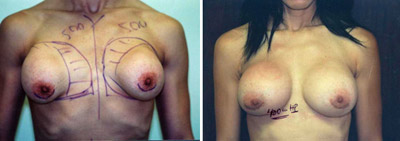When to Get a Breast Revision
Posted On: June 10, 2019 Author: The Office of Dr. Stuart Linder Posted In: Breast Augmentation, Breast Implants, Breast Reconstruction, Breast Revision, Plastic Surgery
There are many reasons why women decide to undergo secondary breast elective breast revision or reoperation. These include capsular contracture, improper initial placement of the implant, rupture of the implant (silicone or saline), bottoming out of the implant, or double bubble deformity implant placed in a pocket superiorly retropositioned with overlap of skin or simply a decision to make a change in the size or volume of the implant.
Capsular contracture is associated with scar tissue formation around the implant which leads to tightening and hardening with visible distortion and ensuing painful deformity. This can be repaired by either an open capsulectomy with removal of the scar issue directly or a capsulotomy where the scar tissue is released. Capsulotomies are preferred in women with minimal breast tissue in order to reduce the visibility of the implant edge.
Improper placement of the implant by a previous surgery may lead to a myriad of deformities or problems. This may include implants placed too high. This can be seen with transaxillary breast augmentation procedures where the muscle is not adequately released and the implants are superiorly retropositioned.
Revision or reconstruction / reoperation will include releasing the lower pole or the inferior portion of the breast pocket to allow the implant to the positioned in the normal anatomical position. Bottoming out may gravitational dissent of the tissue skin and the implant. Fixing this can be difficult and may require either repairing the capsule internally, sometimes difficult if not impossible to do, versus a breast lift which will remove redundant skin from the lower pole of the breast and reposition the nipple superiorly.Rupturing of the silicone or saline breast implant may occur, requiring certainly reoperation.
Rupturing of the silicone or saline breast implant may occur, requiring certainly reoperation. A ruptured saline implant becomes quite obvious as it will with the all or non phenomenon deflate over a reasonably short period of time and the obvious asymmetry will be present. The deflated implant should be removed as soon as possible to reduce the amount of scar tissue contracture around the implant as it becomes smaller. Ruptured silicone implants may be more difficult to determine, however, MRI studies have made it much more predictable and sensitive to determine a small rupture in the silicone bag. These implants should certainly be replaced if ruptured.
A double bubble deformity simply is usually associated with the implants superiorly positioned under the muscle and the overhang of skin drooping over it. This usually will require a combination of surgical procedures, including an open capsulectomy (removing the scar tissue and dropping the implant to its proper position) and a formal mastopexy. This is a true breast lift where excess skin from the lower pole of the breast must be removed with the nipple positioned higher. In summation, once a woman has had breast implants, it is not unlikely or unusual that sometime in the future she will have to undergo a secondary surgery for one of the above problems that may occur.
The repairs again may include removing and replacing the implants with saline and/or silicone, performing a breast lift in order to remove or reduce the excess skin capsulorraphy which may require internally tightening of the capsule, capsulectomies and capsulotomies which simply are removing or releasing scar tissue to allow for a normal shape and reduce pain when there is severe tightening of the breasts.

